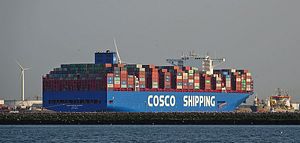Tushar Vyas works for the Subati Flower Company in Kenya, where he manages a 35-hectare flower farm. He has packed some of his roses so they can be shipped to Shanghai for potential buyers at the China International Import Expo (CIIE). Kenya is Africa’s biggest flower exporter, and the fourth largest in the world, and China has become the fastest growing market for its roses. It takes less than two days for Kenyan roses to reach vases in Chinese households.
The Subati Flower Company is among the more than 3,600 companies from over 170 countries attending the CIIE, the world’s first national-level import expo. It is an addition to China’s 60-plus year history organizing the China Import and Export Fair, also known as the Canton Fair, the country’s largest trade fair.
Many people might be aware that China is the world’s largest trading nation for goods, and the world’s largest exporter. But a lesser-known fact is that for the past nine years it has also been the world’s second-largest importer of merchsandise. Even so, people in China are still not fully satisfied with the quantity, quality, and variety of the imported goods on offer. The increase in their wealth and the change in their lifestyle is liberating the capacity for consumption of China’s 1.3 billion people. People across China are poised to buy more from the world, and the government is backing them by sending a clear signal to the world through the CIIE.
Consumption-led growth in China is gaining traction. Official statistics show that China’s total consumption expenditure stood at 43.5 trillion yuan (about $6.3 trillion) in 2017, accounting for 53.6 percent of its GDP, and consumption contributed 58.8 percent to the country’s economic growth. Yet this ratio is still below the international average, which is 80 percent for developed countries and 70 percent for the developing world, according to the World Bank. It’s not hard to come to the conclusion that there is great potential for further consumption in China, and imported commodities have a big role to play. China’s imports in 2017 were worth $1.8 trillion, an increase of 15.9 percent year-on-year. As China’s President Xi Jinping said at the CIIE, over the next 15 years, China’s imports of goods and services are expected to exceed $40 trillion.
The acceleration in purchases from the rest of the world is not a makeshift decision made to temporarily offset the negative effects of trade conflicts. Rather, the CIIE has long been envisioned, and was announced by Xi during the Belt and Road Forum for International Cooperation in May last year, partly to commemorate the 40th anniversary of China’s reform and opening up. China believes in doing what has been proven to be successful, and the reform and opening up has been a success. There is no way that China will close its door to the world, despite the rising tides of trade protectionism and isolationism.
China has already taken concrete measures to further its opening. Starting November 1, China reduced tariffs on 1,585 imported commodities, and in doing so cut the total tariff level from 9.8 percent in 2017 to 7.5 percent. And at the CIIE, China announced plans to make certain volumes of imported goods tariff exempt. At the expo site, supply-demand matchmaking, and one-stop services to assist businesses with customs declarations, transportation, and exhibitions have been made available.
With the ever-changing tastes of China’s consumers, international vendors have to adjust their strategies, and localize their products and sales in order to achieve the most desirable results. Having been open to the world for 40 years, it’s not easy to grab a share of China’s highly competitive and picky domestic market, but the CIIE provides an opportunity to feel its pulse.
Lower tariffs lead to lower prices for consumers and heightened pressure on domestic manufactures. But to restructure China’s economy so it’s more competitive and resilient, redundant and low-level production capacity will need to be phased out sooner rather than later, and external pressure will be a catalyst to push this process forward. China’s government is putting great effort into leveling the playing field for domestic products and imported commodities. In the latest “Doing Business Index 2019” released by the World Bank, China’s position has been sharply raised 32 places, and now ranks 46th among the world’s more than 190 economies.
China’s commitment to reform and opening up is well founded. By buying more from the world, the country has much to give, as it has been doing. It sincerely believes that a “winner takes all” approach to trade is unsustainable, and that an inclusive and multilateral trading system will deliver mutual benefits and greater prosperity.
Wang Shanshan is a current affairs commentator based in Beijing.

































